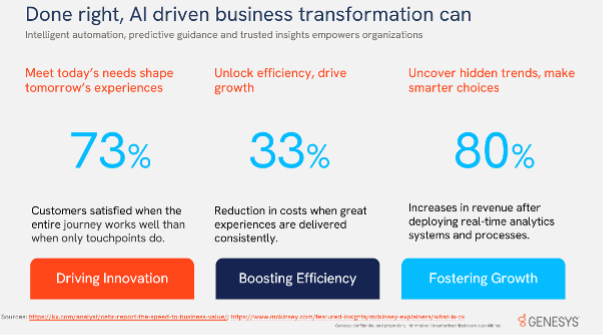Your Genesys Blog Subscription has been confirmed!
Please add genesys@email.genesys.com to your safe sender list to ensure you receive the weekly blog notifications.
Subscribe to our free newsletter and get blog updates in your inbox
Don't Show This Again.

In today’s competitive landscape, customer experience (CX) is a battleground. Leaders and decision-makers understand that a well-run contact centre is no longer just a cost centre; it’s a strategic revenue driver. Investing in the right technologies is crucial, and artificial intelligence (AI) is emerging as a game-changer for maximising ROI.
In this article, we outline the two facets of ROI you should consider: How virtual assistants can add value in the contact centre and specific metrics to track so you can fully understand where you’re gaining the most value from conversational AI. We’ll also explore some steps for deploying virtual assistants in your contact centre so that you’re set up for success.
Traditionally, ROI in contact centres focused on cost reduction. Conversational AI disrupts this paradigm by offering a two-pronged approach:

Virtual agents powered by conversational AI technology can help significantly improve your contact centre ROI. Here are a few advantages you should expect.
Always-on customer service: Virtual agents provide 24/7 customer engagement, ensuring your business is never closed — and customers can get support when it works best for them, even without human intervention. They can answer basic inquiries, deflecting customer calls and freeing up human agents for complex issues. This translates to faster resolutions and happier customers.
Omnichannel accessibility: Virtual agents go where your customers are. They operate on multiple platforms like messaging apps, social media, SMS and online portals to create a seamless omnichannel experience. This accessibility builds brand trust and fosters stronger customer relationships.
Consistent brand voice: Virtual agents can be programmed to communicate in your brand’s specific tone and voice. This consistency fosters familiarity and trust with customers, enhancing the overall experience. Additionally, virtual agents can be used for personalised product recommendations, increasing customer satisfaction and driving sales.
Global reach without borders: Virtual agents can handle customer interactions in multiple languages, eliminating language barriers and expanding your market reach. This removes the need for multilingual human agents, making global customer engagement more efficient and cost-effective.
Enhanced efficiency through automation: Virtual agents can automate repetitive tasks like answering FAQs using a knowledge base, conducting customer satisfaction surveys, and providing insights for sales process improvement. This frees up human agents to focus on higher-value interactions with customers and strategic tasks, boosting overall team productivity.
By implementing voice assistants, leaders can unlock significant ROI through improved customer service, increased sales opportunities and optimised operational costs.
Measuring the ROI of artificial intelligence goes beyond simply tracking cost savings. While reducing agent workload and deflecting calls are valuable benefits, true success lies in understanding how the technology impacts customer behaviour and overall business health.
Here’s how to look beyond the numbers — at specific KPIs you can track to quantify the benefits and the impact on customer behaviour and overall business health.
By combining these metrics with traditional cost-saving data, leaders gain a holistic view of how conversational AI affects the bottom line. This comprehensive picture allows for continuous improvement and optimisation of CAI deployments, ensuring maximum ROI for your contact centre.
Building a virtual agent with the Genesys Cloud® platform is surprisingly easy. A drag-and-drop interface replaces complex coding, allowing for rapid deployment. Still, a successful conversational AI implementation requires careful planning.
Here are three key considerations to ensure it goes smoothly:
Cloud-based contact centre solutions offer a robust platform that empowers organisations to maximise the ROI of conversational AI. Here’s how:
Conversational AI isn’t a silver bullet for the contact centre. It’s a powerful tool for boosting contact centre performance. By focusing on both cost reduction and revenue generation, leaders can unlock significant ROI and build a future-proof contact centre that delivers exceptional customer experiences.
The future of ROI in contact centres lies not in replacing human agents, but in creating a harmonious collaboration between humans and AI.
By embracing this human-AI partnership, contact centres can unlock a future of exceptional customer experiences and maximised ROI. They’ll also create a competitive edge in the ever-evolving digital landscape. The future of contact centres isn’t about replacing the human touch, it’s about amplifying it.
Ready to get started with AI? Read this ebook “How to build your business case for AI” to learn how to gain buy-in from stakeholders.
And find out why IDC Marketscape named Genesys a Leader in delivering conversational AI solutions in front-office customer service environments.
Subscribe to our free newsletter and get the Genesys blog updates in your inbox.